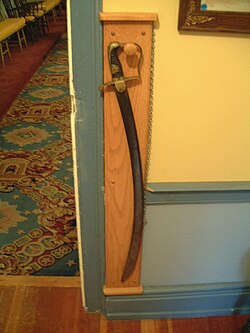Pattern 1796 light cavalry sabre
| Pattern 1796 Light Cavalry Sabre | |
|---|---|

A 1796 Pattern Light Cavalry sabre, adopted for use as a Masonic ceremonial sword. Freemasons' Building, Niagara-on-the-Lake, Canada (2007)
|
|
| Production history | |
| Designer | John Le Marchant/Henry Osborn |
| Designed | 1796 |
| Manufacturer | Various |
| Produced | 1796-1821 |
| Specifications | |
| Length | Blade - 32.5–33 in (83–84 cm) |
|
|
|
| Blade type | Curved, single fuller, asymmetric point. |
| Hilt type | Single knucklebow of "stirrup" type. |
| Scabbard/sheath | Iron, 2 loose suspension rings |
The Pattern 1796 Light Cavalry Sabre is a sword that was used primarily by British Light Dragoons and hussars, and King's German Legion light cavalry during the Napoleonic Wars. It was adopted by the Prussians (as the 1811 pattern or "Blücher sabre") and used by Portuguese and Spanish cavalry.
During the early part of the French Revolutionary War, the British Army launched an expeditionary force into Flanders. With the invading army was a young captain of the 2nd Dragoon Guards, serving as a brigade major, John Gaspard Le Marchant. Le Marchant noted the lack of professional skill displayed by the horsemen and the clumsy design of the heavy, over-long swords then in use and decided to do something about it. Among many other things Le Marchant did to improve the cavalry, he designed, in collaboration with the Birmingham sword cutler Henry Osborn, a new sabre. This was adopted by the British Army as the Pattern 1796 Light Cavalry Sabre.
An eastern influence can be detected in the blade form, and Le Marchant is recorded as saying that the "blades of the Turks, Mamalukes, Moors and Hungarians [were] preferable to any other". The blade profile is similar to some examples of the Indian tulwar, and expert opinion has commented upon this. This similarity prompted some Indian armourers to re-hilt old 1796 pattern blades as tulwars later in the 19th century.
The 1796 sabre had a pronounced curve, making the kind of slashing attacks used in cavalry actions decidedly easier. Even cavalrymen trained to use the thrust, as the French were, in the confusion of a melee often reverted to instinctive hacking, which the 1796 accommodated. Its blade, unlike other European sabres of the period, widened near the point. This affected balance, but made slashes far more brutal; its action in the cut has been compared to a modern bacon slicer. It is said that this vicious design prompted unofficial complaints from French officers, but this is unconfirmed. The blade of the light cavalry sabre was from 32.5 to 33 inches (83 to 84 cm) in length and had a single broad fuller on each side. The sabre was lighter and easier to use than its heavy cavalry counterpart, the pattern 1796 Heavy Cavalry Sword, which had a less 'scientific' design. The hilt was of the simple 'stirrup' form with a single iron knucklebow and quillon, so as to be free of unnecessary weight; the intention of this was to make the sabre usable by all cavalrymen, not solely the largest and strongest. In common with the contemporary heavy cavalry sword, the iron backpiece of the grip had ears which were riveted through the tang of the blade to give the hilt and blade a very secure connection. The grip was of ridged wood covered in leather. It was carried in an iron scabbard, with wooden liners, and hung from the waist via sword-belt slings attached to two loose suspension rings.
...
Wikipedia
